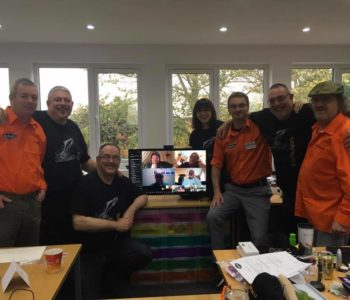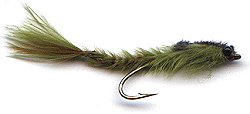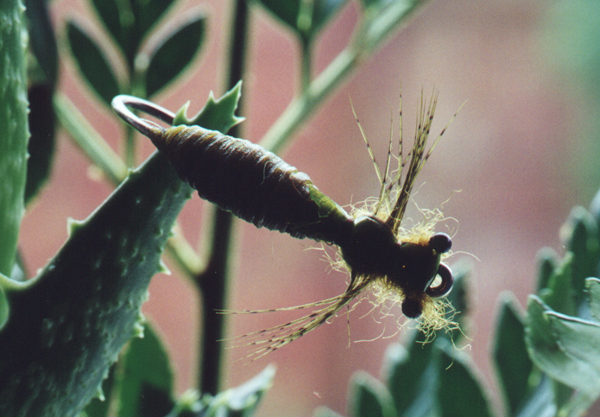
Avalon Permit Fly (1)
To design a totally new fishing fly that catches lots of fish all over the world is not easy. To develop a pattern that has not been tied before anywhere else on the globe is almost impossible. It is so difficult because not all fly tiers share their creations with the world, and because there are so many people who tie their own flies nowadays. It usually takes some time before a new innovative fly pattern has been approved and is well accepted. Most of the world-renown fly patterns rise to the top, so to speak, so when catches are really good, the recognition and acceptance will come a little faster. However, when a particular fish species is normally extremely hard to catch, then people can really go mad when successes with certain fly patterns keeps succeeding over and over again. This actually is exactly what happened with Mauro Ginevri’s permit fly in the waters around Cuba, and the news of his incredible fly pattern is actually spreading quite rapidly. The Avalon Permit Fly is a pretty cool rather new pattern for Permit that actually works, and as it seems lately, not only at one location either. Catch results are starting to come in from other parts of the Caribbean, and that is not only good news for all the Permit fishermen worldwide, but also for all those people that have tried for so long and so hard, and never got the chance to hook one. I even caught pike, lake trout and pacu with the Avalon fly but many more predators will grab for sure.

A lot of people told me that permit fishing can be very boring, even frustrating, and I indeed had several such moments. I also experienced it as unbelievably challenging. I am not a hunter at all, but in a way, I often felt as if a big fish hunter had been awakening inside me each time we were after permit. I also was very fortunate to fish in a few areas where many other species show up often, and that is far from boring when looking for permit. Only when there is no sign of fish, then people easily get bored or even start to dislike permit fishing. Fly fishing for permit is far from easy, that is very true, but because it is so hard, I also can understand why people fish or wanted to fish for permit so fervently. I even know five very nice guys, good friends of mine, who spend a real fortune trying to catch their first ever permit, and Mauro’s new fly hopefully can help them and lead them to success. It does not happen very often that so many saltwater fly fishers become completely crazy about a new fly pattern so quickly, as has happened with the Avalon Permit Fly.
How unique, spectacular and revolutionary this permit pattern really is, was proven to me when I caught my first Grand Slam about 8 years ago in Cuba. Without Mauro’s fly I never ever would have been able to catch the permit that lead me to the success of my Grand Slam. In my ignorance and only follow the books, I surely would have chosen a crab imitation, but why use a crab pattern when the permit in the region feed exclusively on shrimp. Being a little more experienced now, I also realize that my crabs would not been heavy enough to succeed in the waters that I was fishing anyway.

Things progress rapidly, and meanwhile Mauro’s new and different permit fly will have been shown to the world by writers, fly tiers, owners of travel agencies, editors, publishers and all the fishermen who have already succeed with this fly, and landed their permit in the Caribbean Sea. Although Mauro never got the chance to show his pattern to the world himself, some serious fly tying demonstrations regarding his creation have been take place in Canada, USA, UK, Denmark, Netherlands, Malaysia and Italy.
I had several chats with Mauro about his pattern in the evenings after fishing. We also had a very long and serious discussion about the thoughts behind his fly, and how he came up with his pattern. I personally also like to know how other fly tiers think, and how they work. Of course we also talked a lot about the tying techniques and materials that he used to develop his final creation. I feel really privileged to know exactly how his fly has been constructed, and it is great to learn each individual tying step from the original designer. Certain proportions of the Avalon Permit Fly are so crucial that if one of them is incorrectly, the success of fly is lost as well. I therefore feel very grateful that Mauro asked me personally to help him with a correct publication on his pattern, so misunderstandings and incorrect proportions while tying his fly will be prevented. I have to warn you also that from many commercial tied Avalon Permit Flies most were tied wrongly and therefore less effective or even useless.

Mauro feels very proud of his creation, but instead of keeping the fly for himself, he is eager to show and share it with everybody freely and without any hesitation. There were no secrets withheld during all our talks, and so the truth about the fly’s success is the fact that it is not only the pattern that made this fly the most successful permit pattern in Cuba’s Cayo Largo ever, but a combination of several factors:
- in Avalon’s Caribbean fly fishing paradise in Cayo Largo, there is a very good population of hungry permit that are not feeding on crabs but mainly on shrimp.
- the feeding grounds that fit so perfectly to the permit environment are very well protected from all commercial fishing.
- Avalon has a daily restriction to stay away from at least one of their six large fishing areas to prevent over fishing, and thus keep the fly fishing at a very high standard.
- there are a good number of feeding stingrays who not only help the permit to find their food more easily, but also help the fisherman to locate the permit a lot easier.
- the guides all were closely involved in the development of the pattern, so they know exactly how to lead the guest to success.
- the colours of the fly have to blend as close as possible with the bottom
Mauro Ginevri was born in Civitanova Marche in Italy in 1963. Since 1996 he lives in Cuba, where he almost immediately started saltwater fly-fishing . In May 2000, a big dream he had came to fruition when he started to work as manager at the fly fishing lodge in Cayo Largo. Mauro’s son, Mario, caught his first little permit at the age of seven. Since March 2008, Mauro has been involved with Avalon Company, when they took over Villa Marinera and the fishing lodge.

The Avalon permit fly is the result of many years of intensive research. Since the new Millennium started Mauro has fished diligently for permit, using mostly crabs and shrimp patterns that were tied by the world’s most famous saltwater fly tiers. Many flies also were given to him by the guests, but due to lack of success, he began tying his own flies in 2001. It was not easy for Mauro, with hardly any fly tying materials and tying tools available. He learned his fly tying techniques by studying books and magazines that were left behind by the fishing guests. He used the materials that kind fishermen left behing for him. Exactly like what I did in the 1970’s, his real tying skills however, first started to develop when he took flies apart in the opposite way that they had been tied. This is how he studied the special techniques that the big masters were using when they put their flies together. His eagerness, enthusiasm and fanaticism for fly tying did the rest. Today, his biggest hobby is tying bonefish, permit and tarpon flies.

Because of his passion for permit, the way he observed things and his enormous motivation to study the behavior of the permit, he noticed quickly how easily permit became scared, and as a result, too nervous to catch. I experienced myself how spooky they really can be. In many other situations, Mauro discovered how permit often followed the fly during the first two-three strips, and then suddenly got spooked and changed direction. Mauro also discovered that many of the flies that were meant to fish upside down, rolled over or on their side when stripped and he absolutely didn’t like that.
Most fishermen will discover very quickly that permit are a not just a suspicious fish, but also very clever one. They know quite well how to avoid getting hooked, and therefore we see them as extremely shy. I discovered this in Jardines de la Reina when my guide Yensy told me to take another crab when one of the rubber legs was missing. I asked him if the permit could count the legs of a crab? He did not answer me, but he smiled in a way that looked like a yes to me.
Meanwhile, completely addicted to fly tying, Mauro had only one thing in mind. He wanted to increase his catches with a pattern that could really catch permit instead of spooking them. He also wanted to prove to himself that he was correct in his thoughts and strategies regarding permit that came to mind during all the intense research work. Finally, he wanted to design a fly that not only works in Cayo Largo, but in other locations in Caribbean as well. It became a serious obsession for Mauro to develop a pattern that sinks with a harmonious and elegant movement, while the hook stays upside down at all times, regardless of any retrieval speed. The solution came from the swimming pool near Mauro’s tying room. He started to design and develop many creations, and each of them went through serious and intensive tests in the swimming pool, observed by snorkeling, and retrieved or stripped at different speeds by one of the guides. While being underwater, Mauro studied the action, position, mobility, sinking speed, and behavior of each fly. The guides were a great help and they gave Mauro a lot of suggestions and tips for improvements. Each prototype that passed Mauro’s tests were further tested at the permit locations by Mauro himself, the guides and even dozens of the customers.

The Avalon Permit fly is not a crab, but a shrimp pattern, and the main questions is why did Mauro construct his shrimp so long? The answer is simple: Several years ago while Mauro was studying about what kind of food the permit was most interested in at Cayo Largo, he searched the flats and feeding grounds of the permit together with master guide William. Snorkeling and diving was not really the best option to find the food, and therefore they used a little net to search for the available food. Together they pulled the net over distances of almost 100 meters, and discovered on nearly every run they made, at least a dozen or more shrimp that were quite long (over 9 cm) and darker then the Gotcha fly.
After several years of intensive research, many prototypes of flies, and still poor catches, the first successful permit fly design started to get a lot closer. In 2007 one of Mauro’s customers showed him a fly with an extra attached keel system. Immediately Mauro began to think and experiment in a completely different direction, and started to design his first fly patterns with this unique keel system. When Mark Bowler, publishing editor of Fly Fishing & Fly Tying magazine, was fishing with Mauro in February 2008, they talked a lot about the Grand Slam Crab which swims on an even keel. The story that Mark did on this unique crab was published in the December 2008 issue. After the chats with Mark Bowler, Mauro’s experiments with the keel system re-intensified, but instead of building crabs he kept fixed and focused on designing shrimp and this time with the keel system.
The beaded keel system is very innovative. It is made of just a piece of thick monofilament that is tied from the eye to the bend on top of the hook shank. In reality, you have to envision the fly moving in an upside down position. That means that the keel is actually added underneath the fly with the intention of using it with stainless steel or silver beads to give the fly some extra weight, and to keep the hook in a particular position while fishing. Similarly, I invented the Leadhead in 1984, and forced the nymph to move close to the bottom in an upside down position to prevent the fly from getting stuck in the bottom. The idea of the keel system as used in the Grand Slam Crab and Mauro’s Avalon Permit Fly is not exactly new. Some Crab flies for permit already existed with the keel system since 2003, and I have seen a similar system in the late seventies in the area of Kuhmo in Finland. This one was in use by a pike fisherman who used five lead shots clipped on a much smaller loop underneath one of his upside down pike flies.

Then on the 25th of April, 2009, during another fly tying attempt, Mauro got the final amd magic touch. He was fully concentrated on the latest pattern design, while combining his previous ideas with something completely new that had suddenly come to mind. The ideal length of the claws, the material of the claws and to tie them in a delta wing position were the final keys for which Mauro had been searching for so long. At last, after many years he had found the perfect proportions that finally led to the fly’s enormous success. The keel design was not as easy as it looked in first place, because the monofilament had to have the perfect thickness and strength to hold four silver beads exactly in place, while at same time giving the fly the important extra weight needed to keep the hook in an upside down position. To find the best size for the loop was also a hard job. Thus, when length of the claws, the proper position of the claws, the exact loop size for the keel, the precise thickness of the monofilament and the correct weight of the silver beads were found, only than the fly could be in perfect harmony. The beads can move freely and this allows them to clack or snap when stripped. (A trick tht often work well for large predators in very coloured waters.) The two pieces of zonker strip tied in a delta wing position prevent the fly from rolling over, and keep the pattern exactly in balance, even when retrieving speeds are changing. This time the fly passed the swimming pool test with flying colours, and on the 26th of April, 2009, Mauro gave his latest design to six customers to try in Cayo Largo that week! The result was beyond expectations: Five permit in a week.
Mauro keeps an excellent record of the results of all the catches of each day of the week. His reports not only include the temperature of the air and water, but also the numbers of tarpon that jumped and permit that were lost. Since the 26th of April, 2009, until the 22th of January 2013, there were only 12 permit caught with another fly pattern. Only in that period there were 439 permit hooked and 321 landed, all with the Avalon Permit fly. One permit took the rod and reel, one straightens the hook and 116 broke leader, tippet, backing or just got off! Today in 2018 there more than 700 Permit caught on this awesome fly at Cayo Largo
In part two you can read everything about tying the Avalon Permit Fly
Texts by Hans van Klinken, photographs, Hans van Klinken, Ina Stevens and Mauro Ginevri










